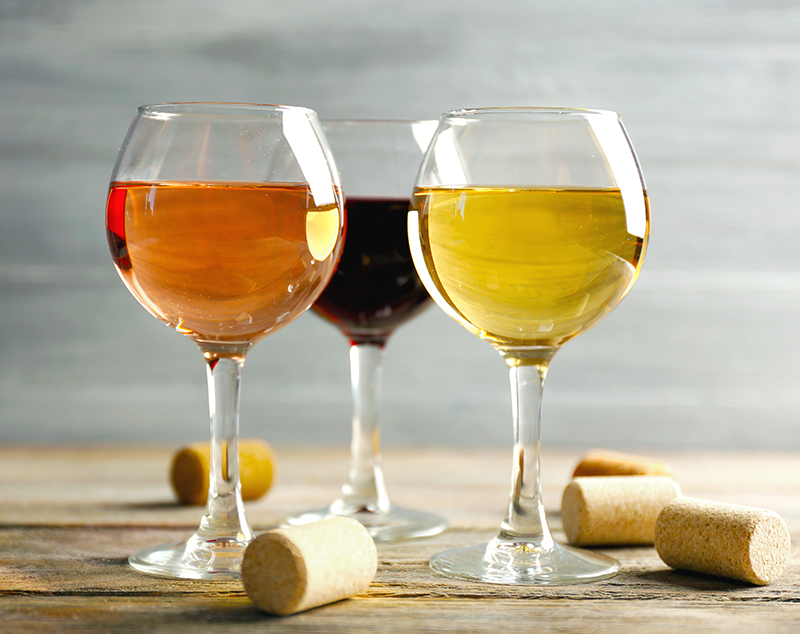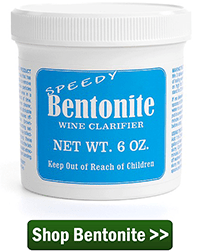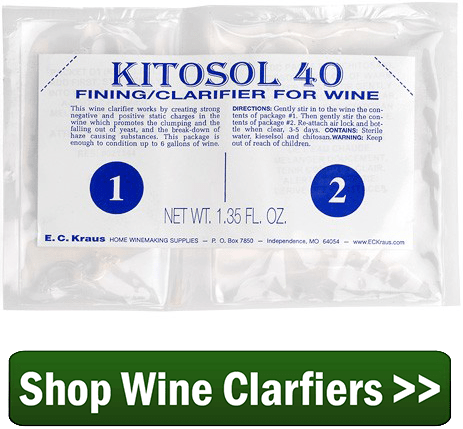 I have 2 batches of fruit wine in the secondary ferment stage, soon to be in for 6 weeks. when it comes to clarity, how clear should wine be before bottling? and if not clear enough, is there a product I can put in it, or should I let it sit a little longer? Pear and peach.
I have 2 batches of fruit wine in the secondary ferment stage, soon to be in for 6 weeks. when it comes to clarity, how clear should wine be before bottling? and if not clear enough, is there a product I can put in it, or should I let it sit a little longer? Pear and peach.
Name: Mr. Sellers
State: Illinois
—–
Mr. Sellers,
The short answer as to how clear your wine should be before you bottle is it should be crystal clear. It should look like a solid hunk of glass when in the wine bottle. There should not be any murkiness or cloudiness to the wine at all. Anything less is a compromise in the quality of the wine.
When you see a haze or cloudiness in a wine it is usually caused by yeast cells or particles still floating within the wine. The wine has not finished stabilizing or has not stopped fermenting.
The little packet of wine yeast that was added at the beginning will regenerate itself by about 100 to 150 times. That’s what you are are usually seeing when a wine doesn’t look clear. Wine yeast is finer than flour. Much finer than can be seen with the naked eye, but collectively it can give the wine this dull appearance.
If the wine is bottled in this condition you will typically end up with bottles of wine that will eventually have dusty deposits at the bottom and a yeasty, sulfur-like smell.
If you are not sure if the wine is clear enough to be bottled, the obvious thing you can do is wait. Give the particles more time to drop out on their own. There is nothing wrong with waiting. The wine will age nicely in bulk. Patience can be a virtue in this situation, however if you are not so patient there are some things you can do to speed things along.
As far as to how to clear a wine, the first thing you can do is treat it with bentonite. This is a wine clarifier or fining agent that is commonly used among wineries. Many wineries will automatically add it to the wine directly after the fermentation has completed. Bentonite is effective in dropping out significant amounts of floating yeast, excessive tannins and other proteins. What it is not good at doing is putting a final, brilliant polish on the wine. This is the glassy-look I referred to earlier.
 To get a final polish, I would suggest using Kitosol 40. This is another fining agent that is particularly good at giving the wine a brilliant appearance, but unlike bentonite it is not good at dropping out large amounts of particles. This makes it a good partner to use after the bentonite — the yin to the yang so to speak.
To get a final polish, I would suggest using Kitosol 40. This is another fining agent that is particularly good at giving the wine a brilliant appearance, but unlike bentonite it is not good at dropping out large amounts of particles. This makes it a good partner to use after the bentonite — the yin to the yang so to speak.
When done, the wine should look beautiful. It should have a pure look about it. Light should glisten and glimmer through it. This is how clear wine should be before bottling.
Hope this helps you out.
Best Wishes,
Ed Kraus
—–
Ed Kraus is a 3rd generation home brewer/winemaker and has been an owner of E. C. Kraus since 1999. He has been helping individuals make better wine and beer for over 25 years.

I make fruit wines in the Philippines. I bottle all my wines as soon as they are finished fermenting. I leave them in the bottle until they clarify, then just before drinking, I rack them. They always clarify, sometimes it takes a year and if the flavor is not right, then it would not have been right doing it the recommended way, some wines will always have a yeasty taste, no matter what you do.
You can do it your way but I suggest you not bottle the wine until it has cleared and settled in bulk. There should be no need to rack the wine from the bottle if it is sufficiently settled and cleared to a brilliant crystal.
I have a question about the Pear Wine Recipe. It states to core the pears & not use a blender or food processor. However, I need to know do you peel the pears too? Thank you for your time, love your recipes and information!
Jonny, you do not need to peel the pears. Just cut them and remove the core.
What I do is peel them on a crank apple peeler, cut them in half remove the core and freeze them in a freezer bag for about a month, then what I do is cook the pears or any fruit in a three level steam juicer. The juice goes into the primary and the fruit in the top level goes into the fu
rmation bag. Steaming the fruit kills all the bad stuff and any wild yeast etc.
I plan to add oak tannin to my bulk wine (in 5 gal. Fermenters). Instructions say to do 2 weeks before bottling. Stirring it in will re-suspend the sediment and likely won’t settle out in 2 weeks. Do you recommend adding the tannin and waiting a month or more until clear again, or racking the wine, adding the tannin, and then bottling in 2 weeks?
I use gelatin. I tried bentonite once, worked well but was such a pain to mix and then created a problem with the drain later. Gelatin has worked fine for me. Ed, do you have any problems or concerns with gelatin?
Also, bentonite can strip some of the flavor I believe. The batch i used bentonite on was. Beautiful. But the blueberries. I i used real blueberries not juice. Anyway the flavor was lacking.
Before bottling, I have been treating with Campden, 24 hours later add Kieselsol a few hours later add Chitosan. Wait 18 to 48 hours before bottling. Is the timing right? Some of my batches are ending up with sediment.
Will I have better results with Campden then Bentonite then Kitosol 40 then bottle? And what timing do you suggest?
Most beginning wine makers want wine to clear immediately, and don’t want to wait. This idea may be arrived at from looking at wine kits which say wine can be ready in as little as 4 weeks. In reality most wines need at least a year before they are ready to drink, so why rush to bottle? If you are new to wine making i suggest that you check out Jack Keller’s website and start learning about more about the process, there is a wealth of information there for free, although donations are accepted. Jack also is working on a wine making book. I believe Jack states almost all wines will fall clear with 3 rackings 60 days apart. After adding fining, your best time to rack is about 3 weeks after, and as Ed Kraus says above wine must be clear to bottle. You can expedite clearing with the Bentonite, Kitosol or other fining agents. Pectic haze can also be an issue which can not be cured by fining. Campden or KMS needs to be added at intervals throughout the winemaking process and Ed Kraus has addressed in other posts, as does Jack Keller. If you are backsweeting you will need to add sorbate. Also if you are trying to rush the process and add fining before wine is stable (all fermentation has ceased) the Co2 generation/concentration will make fining not as effective. Degassing should be done prior to fining .
I’m a new wine maker, I keep hear about exploding bottles. Can you give me advise so this will not happen to me?
It is very easy to make sure you never have exploding bottle. Use a hydrometer confirm that your fermentation has fermented all the sugars from the wine before bottling. If you want to sweeten your wine at bottling time, also add potassium sorbate at the some time, and you will never have a problem.
After adding the potassium sorbate, how long do you wait before drinking the wine?
I have a 5 gallon carboy of a blend of dark muscadine /scuppernong wine that was racked every 30 days for 6 months. It was very clear and had a perfect taste and perfect readings. I added the final 5 crushed Camden tablets and the wine slightly clouded. I read your post to be patient and now 5 months later it’s still slightly cloudy. It’s cleared some but not perfectly clear. Been wine making for 15 years and not had one do this. Should I continue to wait this out or is is time for additives.
I would suggest time. Time is on my side yes it is! But if you are inpatient then listen to Ed. I made a delicious batch of peach once. Never fully cleared but was delicious. So i guess it all depends on what you are going for. I’m a nurse and I have tasting contests with the neighbors. To try and bring some levity back into the lives during these times. They enjoy most of the stuff I’ve made. One batch of apple was horrible. Tasted like something youd use to propel a motor vehicle with. But strawberry, peach, red grape, blueberry all good. I’ve a batch of mead going. Got my fingers crossed hoping it turns out nice. Thinking I may call it Gilgamesh or Beowulf